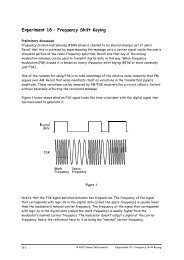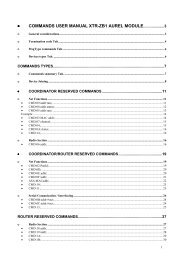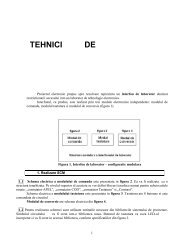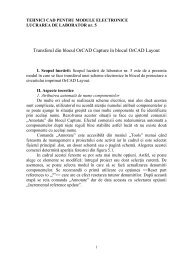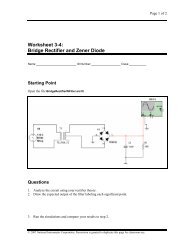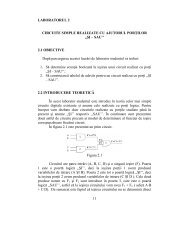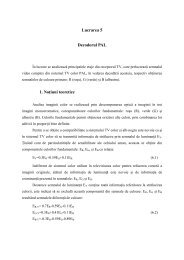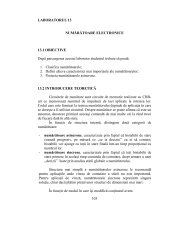Experiment 16 â Bandwidth limiting and restoring digital signals
Experiment 16 â Bandwidth limiting and restoring digital signals
Experiment 16 â Bandwidth limiting and restoring digital signals
You also want an ePaper? Increase the reach of your titles
YUMPU automatically turns print PDFs into web optimized ePapers that Google loves.
<strong>Experiment</strong> <strong>16</strong> – <strong>B<strong>and</strong>width</strong> <strong>limiting</strong> <strong>and</strong> <strong>restoring</strong> <strong>digital</strong> <strong>signals</strong><br />
Preliminary discussion<br />
In the classical communications model, intelligence (the message) moves from a transmitter to<br />
a receiver over a channel. A number of transmission media can be used for the channel<br />
including: metal conductors (such as twisted-pair or coaxial cable), optical fibre <strong>and</strong> free-space<br />
(what people generally call the “airwaves”).<br />
Regardless of the medium used, all channels have a b<strong>and</strong>width. That is, the medium lets a<br />
range of signal frequencies pass relatively unaffected while frequencies outside the range are<br />
made smaller (or attenuated). In this way, the channel acts like a filter.<br />
This issue has important implications. Recall that the modulated signal in analog modulation<br />
schemes (such as AM) consists of many sinewaves. If the medium’s b<strong>and</strong>width isn’t wide<br />
enough, some of the sinewaves are attenuated <strong>and</strong> others can be completely lost. In both<br />
cases, this causes the demodulated signal (the recovered message) to no-longer be a faithful<br />
reproduction of the original.<br />
Similarly, recall that <strong>digital</strong> <strong>signals</strong> are also made up of many sinewaves (called the<br />
fundamental <strong>and</strong> harmonics). Again, if the medium’s b<strong>and</strong>width isn’t wide enough, some of them<br />
are attenuated <strong>and</strong>/or lost <strong>and</strong> this can change the signal’s shape.<br />
To illustrate this last point, Figure 1 below shows what happens when all but the first two of a<br />
squarewave’s sinewaves are removed. As you can see, the signal is distorted.<br />
Figure 1<br />
<strong>16</strong>-2<br />
© 2007 Emona Instruments <strong>Experiment</strong> <strong>16</strong> – <strong>B<strong>and</strong>width</strong> <strong>limiting</strong> <strong>and</strong> <strong>restoring</strong> <strong>digital</strong> <strong>signals</strong>
Making matters worse, the channel is like a filter in that it shifts the phase of sinewaves by<br />
different amounts. Again, to illustrate, Figure 2 below shows the signal in Figure 1 but with one<br />
of its two sinewaves phase shifted by 40º.<br />
Figure 2<br />
Imagine the difficulty a <strong>digital</strong> receiver circuit such as a PCM decoder would have trying to<br />
interpret the logic level of a signal like Figure 2. Some, <strong>and</strong> possibly many, of the codes would<br />
be misinterpreted <strong>and</strong> incorrect voltages generated. The makes the recovered message “noisy”<br />
which is obviously a problem.<br />
The experiment<br />
In this experiment you’ll use the Emona DATEx to set up a PCM communications system. Then<br />
you’ll model b<strong>and</strong>width <strong>limiting</strong> of the channel by introducing a low-pass filter. You’ll observe<br />
the effect of b<strong>and</strong>width <strong>limiting</strong> on the PCM data using a scope. Finally, you’ll use a comparator<br />
to restore a <strong>digital</strong> signal <strong>and</strong> observe its limitations.<br />
It should take you about 50 minutes to complete this experiment <strong>and</strong> an additional 20 minutes<br />
to complete the Eye-Graph addendum.<br />
Equipment<br />
Personal computer with appropriate software installed<br />
NI ELVIS plus connecting leads<br />
NI Data Acquisition unit such as the USB-6251 (or a 20MHz dual channel oscilloscope)<br />
Emona DATEx experimental add-in module<br />
two BNC to 2mm banana-plug leads<br />
assorted 2mm banana-plug patch leads<br />
<strong>Experiment</strong> <strong>16</strong> – <strong>B<strong>and</strong>width</strong> <strong>limiting</strong> <strong>and</strong> <strong>restoring</strong> <strong>digital</strong> <strong>signals</strong> © 2007 Emona Instruments <strong>16</strong>-3
Procedure<br />
Part A – The effects of b<strong>and</strong>width <strong>limiting</strong> on PCM decoding<br />
As mentioned in the preliminary discussion, b<strong>and</strong>width <strong>limiting</strong> in a channel can distort <strong>digital</strong><br />
<strong>signals</strong> <strong>and</strong> upset the operation of the receiver. This part of the experiment demonstrates this<br />
using a PCM transmission system.<br />
1. Ensure that the NI ELVIS power switch at the back of the unit is off.<br />
2. Carefully plug the Emona DATEx experimental add-in module into the NI ELVIS.<br />
3. Set the Control Mode switch on the DATEx module (top right corner) to PC Control.<br />
4. Check that the NI Data Acquisition unit is turned off.<br />
5. Connect the NI ELVIS to the NI Data Acquisition unit (DAQ) <strong>and</strong> connect that to the<br />
personal computer (PC).<br />
6. Turn on the NI ELVIS power switch at the back then turn on its Prototyping Board<br />
Power switch at the front.<br />
7. Turn on the PC <strong>and</strong> let it boot-up.<br />
8. Once the boot process is complete, turn on the DAQ then look or listen for the<br />
indication that the PC recognises it.<br />
9. Launch the NI ELVIS software.<br />
10. Launch the DATEx soft front-panel (SFP) <strong>and</strong> check that you have soft control over the<br />
DATEx board.<br />
11. Slide the NI ELVIS Function Generator’s Control Mode switch so that it’s no-longer in<br />
the Manual position.<br />
12. Launch the Function Generator’s VI.<br />
13. Press the Function Generator VI’s ON/OFF control to turn it on.<br />
14. Adjust the Function Generator using its soft controls for an output with the following<br />
specifications:<br />
<br />
<br />
<br />
<br />
Waveshape: Sine<br />
Frequency: 20Hz<br />
Amplitude: 4Vp-p<br />
DC Offset: 0V<br />
15. Minimise the Function Generator’s VI.<br />
<strong>16</strong>-4<br />
© 2007 Emona Instruments <strong>Experiment</strong> <strong>16</strong> – <strong>B<strong>and</strong>width</strong> <strong>limiting</strong> <strong>and</strong> <strong>restoring</strong> <strong>digital</strong> <strong>signals</strong>
<strong>16</strong>. Connect the set-up shown in Figure 3 below.<br />
MASTER<br />
SIGNALS<br />
FUNCTION<br />
GENERATOR<br />
PCM<br />
ENCODER<br />
PCM<br />
DECODER<br />
GND<br />
PCM<br />
100kHz<br />
SINE<br />
ANALOG I/ O<br />
TDM<br />
TDM<br />
SCOPE<br />
CH A<br />
100kHz<br />
COS<br />
ACH1<br />
DAC1<br />
INPUT 2<br />
FS<br />
FS<br />
CH B<br />
100kHz<br />
DIGITAL<br />
8kHz<br />
DIGITAL<br />
2kHz<br />
DIGITAL<br />
2kHz<br />
SINE<br />
ACH0 DAC0<br />
VARIABLE DC<br />
+<br />
INPUT 1<br />
CLK<br />
PCM<br />
DATA<br />
PCM<br />
DATA<br />
CLK<br />
OUTPUT2<br />
OUTPUT<br />
TRIGGER<br />
Figure 3<br />
This set-up can be represented by the block diagram in Figure 4 below. The PCM Encoder<br />
module converts the Function Generator’s output to a <strong>digital</strong> signal which the PCM Decoder<br />
returns to a sampled version of the original signal. Importantly, the patch lead that connects<br />
the PCM Encoder module’s PCM DATA output to the PCM Decoder module’s PCM DATA input is<br />
the communication system’s “channel”.<br />
Function<br />
Generator<br />
Message<br />
To Ch.A<br />
"Stolen" FS<br />
20Hz<br />
IN<br />
The channel<br />
Output<br />
To Ch.B<br />
CLK<br />
"Stolen" CLK<br />
2kHz<br />
Master<br />
Signals<br />
PCM Encoding<br />
PCM Decoding<br />
Figure 4<br />
<strong>Experiment</strong> <strong>16</strong> – <strong>B<strong>and</strong>width</strong> <strong>limiting</strong> <strong>and</strong> <strong>restoring</strong> <strong>digital</strong> <strong>signals</strong> © 2007 Emona Instruments <strong>16</strong>-5
17. Launch the NI ELVIS Oscilloscope VI.<br />
18. Set up the scope per the procedure in <strong>Experiment</strong> 1 with the following change:<br />
<br />
Timebase control to 10ms/div instead of 500µs/div<br />
19. Activate the scope’s Channel B input to observe the PCM Decoder module’s output as well<br />
as the PCM Encoder module’s input.<br />
Note: If the set-up is working, you should see a 20Hz sinewave for the message <strong>and</strong> its<br />
sampled equivalent out of the PCM Encoder module.<br />
Ask the instructor to check<br />
your work before continuing.<br />
<strong>16</strong>-6<br />
© 2007 Emona Instruments <strong>Experiment</strong> <strong>16</strong> – <strong>B<strong>and</strong>width</strong> <strong>limiting</strong> <strong>and</strong> <strong>restoring</strong> <strong>digital</strong> <strong>signals</strong>
20. Locate the Tuneable Low-pass Filter module on the DATEX SFP <strong>and</strong> set its soft Gain<br />
control to about the middle of its travel.<br />
21. Turn the Tuneable Low-pass Filter module’s soft Cut-off Frequency Adjust control to<br />
about the middle of its travel.<br />
22. Modify the set-up as shown in Figure 5 below.<br />
MASTER<br />
SIGNALS<br />
FUNCTION<br />
GENERATOR<br />
PCM<br />
ENCODER<br />
TUNEABLE<br />
LPF<br />
PCM<br />
DECODER<br />
GND<br />
PCM<br />
f C x10 0<br />
100kHz<br />
SINE<br />
ANALOG I/ O<br />
TDM<br />
TDM<br />
SCOPE<br />
CH A<br />
100kHz<br />
COS<br />
100kHz<br />
DIGITAL<br />
ACH1<br />
DAC1<br />
INPUT 2<br />
FS<br />
f C<br />
FS<br />
CH B<br />
8kHz<br />
DIGITAL<br />
2kHz<br />
DIGITAL<br />
2kHz<br />
SINE<br />
ACH0 DAC0<br />
VARIABLE DC<br />
+<br />
INPUT 1<br />
CLK<br />
PCM<br />
DATA<br />
GAIN<br />
PCM<br />
DATA<br />
CLK<br />
OUTPUT2<br />
OUTPUT<br />
TRIGGER<br />
IN<br />
OUT<br />
Figure 5<br />
The set-up can be represented by the block diagram in Figure 6 below. The Tuneable Low-pass<br />
Filter module models b<strong>and</strong>width <strong>limiting</strong> of the channel.<br />
Message<br />
To Ch.A<br />
Tuneable LPF<br />
"Stolen" FS<br />
20Hz<br />
IN<br />
OUTPUT<br />
To Ch.B<br />
CLK<br />
"Stolen" CLK<br />
2kHz<br />
Figure 6<br />
<strong>Experiment</strong> <strong>16</strong> – <strong>B<strong>and</strong>width</strong> <strong>limiting</strong> <strong>and</strong> <strong>restoring</strong> <strong>digital</strong> <strong>signals</strong> © 2007 Emona Instruments <strong>16</strong>-7
23. Slowly turn the Tuneable Low-pass Filter module’s soft Cut-off Frequency Adjust<br />
control anti-clockwise.<br />
Tip: Use the keyboard’s TAB <strong>and</strong> arrow keys to make fine adjustment of this control.<br />
24. Stop the moment the PCM Decoder module’s output contains the occasional error.<br />
Question 1<br />
What’s causing the errors on the PCM Decoder module’s output? Tip: If you’re not sure,<br />
see the preliminary discussion.<br />
Question 2<br />
If this were a communications system transmitting speech, what would these errors<br />
sound like when the message is reconstructed?<br />
25. Reduce the channel’s b<strong>and</strong>width further to observe the effect of severe b<strong>and</strong>width<br />
<strong>limiting</strong> of the channel on the PCM Decoder module’s output.<br />
Ask the instructor to check<br />
your work before continuing.<br />
<strong>16</strong>-8<br />
© 2007 Emona Instruments <strong>Experiment</strong> <strong>16</strong> – <strong>B<strong>and</strong>width</strong> <strong>limiting</strong> <strong>and</strong> <strong>restoring</strong> <strong>digital</strong> <strong>signals</strong>
You have just seen what b<strong>and</strong>width <strong>limiting</strong> has done to the sampled signal in the time domain<br />
so now let’s look at what happens in the frequency domain.<br />
26. Increase the channel’s b<strong>and</strong>width just until the PCM Decoder’s output no-longer contains<br />
errors.<br />
27. Suspend the scope VI’s operation by pressing its RUN control once.<br />
28. Launch the NI ELVIS Dynamic Signal Analyzer VI.<br />
29. Adjust the Signal Analyzer’s controls as follows:<br />
General<br />
Sampling to Run<br />
Input Settings<br />
<br />
Source Channel to Scope CHB<br />
Voltage Range to ±10V<br />
FFT Settings<br />
Frequency Span to 1,000<br />
Resolution to 400<br />
Window to 7 Term B-Harris<br />
Averaging<br />
Mode to RMS<br />
Weighting to Exponential<br />
# of Averages to 3<br />
Triggering<br />
<br />
Triggering to Immediate<br />
Frequency Display<br />
<br />
Units to dB<br />
<br />
Markers to OFF (for now)<br />
<br />
RMS/Peak to RMS<br />
<br />
Scale to Auto<br />
30. Activate the Signal Analyzer’s markers by pressing the Markers button.<br />
31. Use the Signal Analyzer’s M1 marker to examine the frequency of the sinewaves that<br />
make up the sampled message.<br />
32. Use the M1 marker to locate the sinewave in the sampled message that has the same the<br />
frequency as the original message.<br />
<strong>Experiment</strong> <strong>16</strong> – <strong>B<strong>and</strong>width</strong> <strong>limiting</strong> <strong>and</strong> <strong>restoring</strong> <strong>digital</strong> <strong>signals</strong> © 2007 Emona Instruments <strong>16</strong>-9
33. Reduce the channel’s b<strong>and</strong>width so that the PCM Decoder module’s output contains<br />
occasional errors <strong>and</strong> observe the effect on the signal’s spectral composition.<br />
Tip: Use the Signal Analyzer’s lower display (which is basically a scope) to help you set<br />
the level of errors.<br />
34. Reduce the channel’s b<strong>and</strong>width so that the PCM Decoder module’s output is severely<br />
b<strong>and</strong>width limited <strong>and</strong> observe the effect on the signal’s spectral composition.<br />
Question 3<br />
The Signal Analyzer’s trace should now be much smother than it was before (that is,<br />
fewer peaks <strong>and</strong> troughs). What is this telling you about the spectral composition of the<br />
PCM Decoder module’s output?<br />
Question 4<br />
These extra sinewaves are heard as noise. Why doesn’t the Tuneable Low-pass Filter<br />
module remove them?<br />
Ask the instructor to check<br />
your work before continuing.<br />
<strong>16</strong>-10<br />
© 2007 Emona Instruments <strong>Experiment</strong> <strong>16</strong> – <strong>B<strong>and</strong>width</strong> <strong>limiting</strong> <strong>and</strong> <strong>restoring</strong> <strong>digital</strong> <strong>signals</strong>
Part B – The effects of b<strong>and</strong>width <strong>limiting</strong> on a <strong>digital</strong> signal’s shape<br />
You’ve seen how a channel’s b<strong>and</strong>width can upset a receiver’s operation. Now let’s have a look at<br />
how it affects the shape of the <strong>digital</strong> signal at the receiver’s input.<br />
Importantly, <strong>digital</strong> <strong>signals</strong> that are generated by a message such as a sinewave, speech or<br />
music cannot be used for this part of the experiment. This is because the data stream is too<br />
irregular for the scope to be able to lock onto the signal <strong>and</strong> show a stable sequence of 1s <strong>and</strong><br />
0s. To get around this problem the Sequence Generator module’s 32-bit sequence is used to<br />
model a <strong>digital</strong> data signal.<br />
35. Close the Signal Analyzer VI.<br />
36. Completely dismantle the previous set-up.<br />
37. Set the Tuneable Low-pass Filter module’s soft Gain control to about the middle of its<br />
travel.<br />
38. Turn the Tuneable Low-pass Filter module’s soft Cut-off Frequency Adjust control fully<br />
clockwise.<br />
39. Locate the Sequence Generator module on the DATEx SFP <strong>and</strong> set its soft dip-switches<br />
to 00.<br />
40. Connect the set-up shown in Figure 7 below.<br />
MASTER<br />
SIGNALS<br />
SEQUENCE<br />
GENERATOR<br />
TUNEABLE<br />
LPF<br />
O<br />
LINE<br />
CODE<br />
100kHz<br />
SINE<br />
1<br />
OO NRZ-L<br />
SYNC<br />
O1 Bi-O<br />
1O RZ-AMI<br />
11 NRZ-M<br />
X<br />
f C x100<br />
SCOPE<br />
CH A<br />
100kHz<br />
COS<br />
100kHz<br />
DIGITAL<br />
8kHz<br />
DIGITAL<br />
2kHz<br />
DIGITAL<br />
2kHz<br />
SINE<br />
Y<br />
CLK<br />
SPEECH<br />
GND<br />
GND<br />
f C<br />
GAIN<br />
IN OUT<br />
CH B<br />
TRIGGER<br />
Figure 7<br />
This set-up can be represented by the block diagram in Figure 8 on the next page. The<br />
Sequence Generator module is used to model a <strong>digital</strong> signal <strong>and</strong> its SYNC output is used to<br />
trigger the scope to provide a stable display.<br />
<strong>Experiment</strong> <strong>16</strong> – <strong>B<strong>and</strong>width</strong> <strong>limiting</strong> <strong>and</strong> <strong>restoring</strong> <strong>digital</strong> <strong>signals</strong> © 2007 Emona Instruments <strong>16</strong>-11
Master<br />
Signals<br />
Sequence<br />
Generator<br />
Tuneable LPF<br />
Digital signal<br />
To Ch.A<br />
2kHz<br />
CLK<br />
<strong>B<strong>and</strong>width</strong> limited<br />
<strong>digital</strong> signal<br />
To Ch.B<br />
SYNC<br />
SYNC<br />
To Trig.<br />
Digital signal modelling<br />
BW limited channel<br />
Figure 8<br />
41. Restart the scope’s VI by pressing its RUN control once.<br />
42. Adjust the following scope controls:<br />
<br />
<br />
Trigger Source control to TRIGGER instead of CH A<br />
Timebase control to 1ms/div instead of 500µs/div<br />
43. Note the effects of making the channel’s b<strong>and</strong>width narrower by turning the Tuneable<br />
Low-pass Filter module’s soft Cut-off Frequency Adjust control anti-clockwise.<br />
Question 5<br />
What two things are happening to cause the <strong>digital</strong> signal to change shape? Tip: If<br />
you’re not sure, see the preliminary discussion.<br />
Ask the instructor to check<br />
your work before continuing.<br />
<strong>16</strong>-12<br />
© 2007 Emona Instruments <strong>Experiment</strong> <strong>16</strong> – <strong>B<strong>and</strong>width</strong> <strong>limiting</strong> <strong>and</strong> <strong>restoring</strong> <strong>digital</strong> <strong>signals</strong>
An obvious solution to the problem of b<strong>and</strong>width <strong>limiting</strong> of the channel is to use a transmission<br />
medium that has a sufficiently wide b<strong>and</strong>width for the <strong>digital</strong> data. In principle, this is a good<br />
idea that is used - certain cable designs have better b<strong>and</strong>widths than others. However, as<br />
<strong>digital</strong> technology spreads, there are dem<strong>and</strong>s to push more <strong>and</strong> more data down existing<br />
channels. To do so without slowing things down requires that the transmission bit rate be<br />
increased. This ends up having the same effect as reducing the channel’s b<strong>and</strong>width. The next<br />
part of the experiment demonstrates this.<br />
44. Turn the Tuneable Low-pass Filter module’s soft Cut-off Frequency Adjust control fully<br />
clockwise to make the channel’s b<strong>and</strong>width as wide as possible (about 13kHz).<br />
45. Launch the Function Generator’s VI.<br />
46. Adjust the Function Generator for a 2kHz output.<br />
Note: It’s not necessary to adjust any other controls as the Function Generator’s SYNC<br />
output will be used <strong>and</strong> this is a <strong>digital</strong> signal.<br />
47. Modify the set-up as shown in Figure 9 below.<br />
Note: As you have set up the Function Generator’s output for a signal that’s the same as<br />
the Master Signals module’s 2kHz DIGITAL output, the <strong>signals</strong> on the scope shouldn’t<br />
change.<br />
FUNCTION<br />
GENERATOR<br />
SEQUENCE<br />
GENERATOR<br />
TUNEABLE<br />
LPF<br />
O<br />
LINE<br />
CODE<br />
ANALOG I/ O<br />
1<br />
OO NRZ-L<br />
SYNC<br />
O1 Bi-O<br />
1O RZ-AMI<br />
11 NRZ-M<br />
f C x100<br />
SCOPE<br />
CH A<br />
X<br />
ACH1<br />
DAC1<br />
CLK<br />
Y<br />
f C<br />
CH B<br />
ACH0 DAC0<br />
VARIABLE DC<br />
+<br />
SPEECH<br />
GND<br />
GAIN<br />
TRIGGER<br />
GND<br />
IN<br />
OUT<br />
Figure 9<br />
<strong>Experiment</strong> <strong>16</strong> – <strong>B<strong>and</strong>width</strong> <strong>limiting</strong> <strong>and</strong> <strong>restoring</strong> <strong>digital</strong> <strong>signals</strong> © 2007 Emona Instruments <strong>16</strong>-13
The set-up in Figure 9 can be represented by the block diagram in Figure 10 below. Notice that<br />
the Sequence Generator module’s clock is now provided by the Function Generator’s output <strong>and</strong><br />
so it is variable.<br />
Function<br />
Generator<br />
CLK<br />
Variable<br />
frequency<br />
SYNC<br />
Digital signal<br />
To Ch.A<br />
<strong>B<strong>and</strong>width</strong> limited<br />
<strong>digital</strong> signal<br />
To Ch.B<br />
SYNC<br />
To Trig.<br />
Digital signal modelling<br />
BW limited channel<br />
Figure 10<br />
48. To model increasing the transmission bit-rate, increase the Function Generator’s output<br />
frequency in 5,000Hz intervals until the clock is about 50kHz.<br />
Tip: As you do this, you’ll need to adjust the scope’s Timebase control as well so that you<br />
can properly see the <strong>digital</strong> <strong>signals</strong>.<br />
Question 6<br />
What other change to your communication system distorts the <strong>digital</strong> signal in the same<br />
way as increasing its bit-rate?<br />
Ask the instructor to check<br />
your work before continuing.<br />
<strong>16</strong>-14<br />
© 2007 Emona Instruments <strong>Experiment</strong> <strong>16</strong> – <strong>B<strong>and</strong>width</strong> <strong>limiting</strong> <strong>and</strong> <strong>restoring</strong> <strong>digital</strong> <strong>signals</strong>
Part C – Restoring <strong>digital</strong> <strong>signals</strong><br />
As you have seen, b<strong>and</strong>width <strong>limiting</strong> distorts <strong>digital</strong> <strong>signals</strong>. As you have also seen, <strong>digital</strong><br />
receivers such as PCM decoders have problems trying to interpret b<strong>and</strong>width limited <strong>digital</strong><br />
<strong>signals</strong>. The trouble is, b<strong>and</strong>width <strong>limiting</strong> is almost inevitable <strong>and</strong> its effects get worse as the<br />
<strong>digital</strong> signal’s bit-rate increases.<br />
To manage this problem, the received <strong>digital</strong> signal must be cleaned-up or “restored” before it<br />
is decoded. A device that is ideal for this purpose is the comparator. Recall that the<br />
comparator amplifies the difference between the voltages on its two inputs by an extremely<br />
large amount. This always produces a heavily clipped or “squared-up” version of any AC signal<br />
connected to one input if it swings above <strong>and</strong> below a DC voltage on the other input.<br />
As you know, ordinarily we avoid clipping but in this case it’s very useful. The b<strong>and</strong>width limited<br />
<strong>digital</strong> signal is connected to one of the comparator’s inputs <strong>and</strong> a variable DC voltage is<br />
connected to the other. The b<strong>and</strong>width limited <strong>digital</strong> signal swings above <strong>and</strong> below the DC<br />
voltage to produce a <strong>digital</strong> signal on the comparator’s output. Then, the variable DC voltage is<br />
adjusted until this happens at the right points in the b<strong>and</strong>width limited <strong>digital</strong> signal for the<br />
comparator’s output to be a copy of the original <strong>digital</strong> signal.<br />
Unfortunately, this simple yet clever idea has its limitations. First, b<strong>and</strong>width <strong>limiting</strong> can<br />
distort the <strong>digital</strong> signal too much for the comparator to restore accurately (that is, without<br />
errors). Second, the channel can cause the received <strong>digital</strong> signal (<strong>and</strong> the hence the restored<br />
<strong>digital</strong> signal) to become phase shifted. For reasons not explained here this can cause other<br />
problems for receivers.<br />
This part of the experiment lets you restore a b<strong>and</strong>width limited <strong>digital</strong> signal using a<br />
comparator <strong>and</strong> observe these limitations.<br />
49. Slide the NI ELVIS Variable Power Supplies’ positive output Control Mode switch so that<br />
it’s no-longer in the Manual position.<br />
50. Launch the Variable Power Supplies VI.<br />
51. Set the Variable Power Supplies’ positive output to 0V by pressing its RESET button.<br />
52. Set the scope’s Timebase control to the 1ms/div position.<br />
<strong>Experiment</strong> <strong>16</strong> – <strong>B<strong>and</strong>width</strong> <strong>limiting</strong> <strong>and</strong> <strong>restoring</strong> <strong>digital</strong> <strong>signals</strong> © 2007 Emona Instruments <strong>16</strong>-15
53. Disconnect the patch lead to the Function Generator’s output then modify the set-up as<br />
shown in Figure 11 below.<br />
MASTER<br />
SIGNALS<br />
SEQUENCE<br />
GENERATOR<br />
O<br />
LINE<br />
CODE<br />
TUNEABLE<br />
LPF<br />
FUNCTION<br />
GENERATOR<br />
UTILITIES<br />
COM PARATOR<br />
REF<br />
100kHz<br />
SINE<br />
100kHz<br />
COS<br />
100kHz<br />
DIGITAL<br />
8kHz<br />
DIGITAL<br />
2kHz<br />
DIGITAL<br />
2kHz<br />
SINE<br />
1<br />
OO NRZ-L<br />
O1 Bi-O<br />
1O RZ-AMI<br />
11 NRZ-M<br />
CLK<br />
SPEECH<br />
GND<br />
GND<br />
X<br />
Y<br />
SYNC<br />
IN<br />
f C<br />
GAIN<br />
f C x10 0<br />
OUT<br />
ANALOG I/ O<br />
ACH1<br />
ACH0<br />
VARIABLE DC<br />
+<br />
DAC1<br />
DAC0<br />
IN OUT<br />
RECTIFIER<br />
DIODE & RC LPF<br />
RC LPF<br />
SCOPE<br />
CH A<br />
CH B<br />
TRIGGER<br />
Figure 11<br />
The entire set-up can be represented by the block diagram in Figure 12 below. The comparator<br />
on the Utilities module is used to restore the b<strong>and</strong>width limited <strong>digital</strong> signal.<br />
Digital signal<br />
modelling<br />
BW limited<br />
channel<br />
Restoration<br />
2kHz<br />
CLK<br />
SYNC<br />
REF<br />
IN<br />
Restored<br />
<strong>digital</strong> signal<br />
To Ch.B<br />
Digital signal<br />
To Ch.A<br />
SYNC<br />
To Trig.<br />
Figure 12<br />
<strong>16</strong>-<strong>16</strong><br />
© 2007 Emona Instruments <strong>Experiment</strong> <strong>16</strong> – <strong>B<strong>and</strong>width</strong> <strong>limiting</strong> <strong>and</strong> <strong>restoring</strong> <strong>digital</strong> <strong>signals</strong>
54. Compare the <strong>signals</strong>.<br />
Question 7<br />
Although the restored <strong>digital</strong> signal is almost identical to the original <strong>digital</strong> signal,<br />
there is a difference. Can you see what it is? Tip: If you can’t, set the scope’s Timebase<br />
control to the 100µs/div position.<br />
Question 8<br />
Can this difference be ignored? Why?<br />
Ask the instructor to check<br />
your work before continuing.<br />
55. Return the scope’s Timebase control to the 1ms/div position.<br />
56. Increase the Variable Power Supplies’ positive output in 0.2V intervals <strong>and</strong> observe the<br />
effect.<br />
Question 9<br />
Why do some DC voltages cause the comparator to output the wrong information? Tip:<br />
If you’re not sure, see the notes on page <strong>16</strong>-17.<br />
Ask the instructor to check<br />
your work before continuing.<br />
<strong>Experiment</strong> <strong>16</strong> – <strong>B<strong>and</strong>width</strong> <strong>limiting</strong> <strong>and</strong> <strong>restoring</strong> <strong>digital</strong> <strong>signals</strong> © 2007 Emona Instruments <strong>16</strong>-17
1ORZ-AMI<br />
57. Return the Variable Power Supplies positive output to 0V.<br />
58. Slowly make the channel’s b<strong>and</strong>width narrower by turning the Tuneable Low-pass Filter<br />
module’s soft Cut-off Frequency Adjust control anti-clockwise.<br />
Note: As you do this, the phase difference between the two <strong>digital</strong> <strong>signals</strong> will increase<br />
but ignore this.<br />
Question 10<br />
Why does the comparator begin to output the wrong information when this control is<br />
turned far enough?<br />
59. Make the channel’s b<strong>and</strong>width wider <strong>and</strong> stop when the comparator’s output is the same<br />
as the original <strong>digital</strong> signal (ignoring the phase shift).<br />
60. Compare the restored <strong>digital</strong> signal with the b<strong>and</strong>width limited <strong>digital</strong> signal by<br />
modifying the set-up as shown in Figure 13 below.<br />
MASTER<br />
SIGNALS<br />
SEQUENCE<br />
GENERATOR<br />
O<br />
LINE<br />
CODE<br />
TUNEABLE<br />
LPF<br />
FUNCTION<br />
GENERATOR<br />
UTILITIES<br />
COM PARATOR<br />
REF<br />
10kHz<br />
SINE<br />
10kHz<br />
COS<br />
10kHz<br />
DIGITAL<br />
8kHz<br />
DIGITAL<br />
2kHz<br />
DIGITAL<br />
2kHz<br />
SINE<br />
ONRZ-L<br />
O1Bi-O<br />
1NRZ-M<br />
1<br />
SYNC<br />
X<br />
Y<br />
CLK<br />
SPECH<br />
GND<br />
f C<br />
GAIN<br />
f C x10 0<br />
ANALOG I/ O<br />
ACH1 DAC1<br />
ACH0 DAC0<br />
VARIABLE DC<br />
+<br />
IN OUT<br />
RECTIFIER<br />
DIODE & RC LPF<br />
RC LPF<br />
SCOPE<br />
CHA<br />
CHB<br />
TRIGER<br />
GND<br />
IN<br />
OUT<br />
Figure 13<br />
<strong>16</strong>-18<br />
© 2007 Emona Instruments <strong>Experiment</strong> <strong>16</strong> – <strong>B<strong>and</strong>width</strong> <strong>limiting</strong> <strong>and</strong> <strong>restoring</strong> <strong>digital</strong> <strong>signals</strong>
Question 11<br />
How can the comparator restore the b<strong>and</strong>width limited <strong>digital</strong> signal when it is so<br />
distorted?<br />
Ask the instructor to check<br />
your work before finishing.<br />
<strong>Experiment</strong> <strong>16</strong> – <strong>B<strong>and</strong>width</strong> <strong>limiting</strong> <strong>and</strong> <strong>restoring</strong> <strong>digital</strong> <strong>signals</strong> © 2007 Emona Instruments <strong>16</strong>-19
Eye diagrams<br />
Regardless of whether the <strong>digital</strong> data is received from a satellite or the optical head<br />
of a CD drive, it’s important to be able to inspect <strong>and</strong> test its distortion (that is, the<br />
channel b<strong>and</strong>width & phase characteristics) <strong>and</strong> degradation (that is, the channel<br />
noise). One method of doing so involves using the received <strong>digital</strong> signal to develop an<br />
Eye Diagram.<br />
Eye diagrams can be readily set-up using a st<strong>and</strong>-alone scope or an Eye Diagram Virtual<br />
Instrument if the NI ELVIS test equipment is being used. For both, multiple sweeps of<br />
the scope are overlayed one upon another producing a display much like Figure 1 below.<br />
Figure 1<br />
As you can see, the spaces between the logic-1s <strong>and</strong> logic-0s produce “eyes” in the<br />
centre of the display. Importantly, the greater the effect of b<strong>and</strong>width <strong>limiting</strong> <strong>and</strong><br />
phase distortion, the less ideal the logic levels become <strong>and</strong> so the eyes begin to “close”.<br />
In addition, channel noise appears as erratic traces across the centre of the eye<br />
though a scope with a very long persistence is needed to capture them if the Eye<br />
Diagram VI is not being used.<br />
If time permits, this activity gets you to develop an Eye Diagram <strong>and</strong> observe the<br />
effect of noise <strong>and</strong> b<strong>and</strong>width <strong>limiting</strong> on its eyes.<br />
<strong>16</strong>-20<br />
© 2007 Emona Instruments <strong>Experiment</strong> <strong>16</strong> – <strong>B<strong>and</strong>width</strong> <strong>limiting</strong> <strong>and</strong> <strong>restoring</strong> <strong>digital</strong> <strong>signals</strong>
1. Completely dismantle the existing set-up.<br />
Note: If you’re attempting this part of the experiment without having just completed<br />
the previous part, perform Steps 1 to 10 on page <strong>16</strong>-4.<br />
2. Check that the Sequence Generator module’s soft dip-switches are set to 00.<br />
3. Connect the set-up shown in Figure 2 below.<br />
NOISE<br />
GENERATOR<br />
FUNCTION<br />
GENERATOR<br />
SEQUENCE<br />
GENERATOR<br />
CHANNEL<br />
MODULE<br />
0dB<br />
O<br />
LINE<br />
CODE<br />
-6 dB<br />
-20dB<br />
AMPLIFIER<br />
ANALOG I/ O<br />
ACH1<br />
DAC1<br />
1<br />
OO NRZ-L<br />
O1 Bi-O<br />
1O RZ-AMI<br />
11 NRZ-M<br />
CLK<br />
X<br />
Y<br />
SYNC<br />
CHANNEL<br />
BPF<br />
BASEBAND<br />
LPF<br />
ADDER<br />
SCOPE<br />
CH A<br />
CH B<br />
IN<br />
GAIN<br />
OUT<br />
ACH0 DAC0<br />
VARIABLE DC<br />
+<br />
SPEECH<br />
GND<br />
NOISE<br />
SIGNAL<br />
CHANNEL<br />
OUT<br />
TRIGGER<br />
GND<br />
Figure 2<br />
This set-up can be represented by the block diagram in Figure 3 below.<br />
Function<br />
Generator<br />
Sequence<br />
Generator<br />
Adder<br />
Baseb<strong>and</strong><br />
LPF<br />
CLK<br />
<strong>B<strong>and</strong>width</strong> limited<br />
noisy <strong>digital</strong> signal<br />
Bit-clock<br />
To Ch.B & Trig<br />
Noise<br />
generator<br />
Noisy <strong>digital</strong><br />
signal<br />
To Ch.A<br />
Digital signal modelling<br />
Noisy & b<strong>and</strong>width limited channel<br />
Figure 3<br />
<strong>Experiment</strong> <strong>16</strong> – <strong>B<strong>and</strong>width</strong> <strong>limiting</strong> <strong>and</strong> <strong>restoring</strong> <strong>digital</strong> <strong>signals</strong> © 2007 Emona Instruments <strong>16</strong>-21
The Sequence Generator module is used to model a <strong>digital</strong> signal <strong>and</strong> its bit-clock is provided<br />
by the function generator so the data rate can be varied. An Adder is used to add noise to the<br />
<strong>digital</strong> signal that can be varied from -20dB (lowest) to 0dB (highest. The signal is finally<br />
b<strong>and</strong>width limited by the Baseb<strong>and</strong> LPF.<br />
4. Slide the NI ELVIS Function Generator’s Control Mode switch so that it’s in the Manual<br />
position.<br />
5. Launch the NI ELVIS Oscilloscope VI.<br />
6. Set up the scope per the procedure in <strong>Experiment</strong> 1 with the following changes:<br />
<br />
<br />
Trigger Source control to TRIGGER instead of CH A<br />
Timebase control to 1ms/div instead of 500µs/div<br />
7. Activate the scope’s Channel B input to observe the Sequence Generator module’s bitclock<br />
as well as the <strong>digital</strong> data on the Tuneable Low-pass Filter module’s output.<br />
8. Use the Function Generator’s hard frequency adjust controls to set the Sequence<br />
Generator module’s bit-clock frequency to 2kHz (as measured using the scope).<br />
Note: Once done, you should observe a <strong>digital</strong> signal with an obvious noise component.<br />
9. Increase the <strong>digital</strong> signal’s noise component to -6dB <strong>and</strong> observe the effect.<br />
10. Increase the <strong>digital</strong> signal’s noise component to 0dB <strong>and</strong> observe the effect.<br />
11. Return the <strong>digital</strong> signal’s noise component to -20dB.<br />
12. Modify the set-up as shown in Figure 4 below.<br />
NOISE<br />
GENERATOR<br />
FUNCTION<br />
GENERATOR<br />
SEQUENCE<br />
GENERATOR<br />
CHANNEL<br />
MODULE<br />
LINE<br />
CODE<br />
0dB<br />
O<br />
-6 dB<br />
-20dB<br />
AMPLIFIER<br />
ANALOG I/ O<br />
ACH1<br />
DAC1<br />
1<br />
OO NRZ-L<br />
O1 Bi-O<br />
1O RZ-AMI<br />
11 NRZ-M<br />
CLK<br />
X<br />
Y<br />
SYNC<br />
CHANNEL<br />
BPF<br />
BASEBAND<br />
LPF<br />
ADDER<br />
SCOPE<br />
CH A<br />
CH B<br />
IN<br />
GAIN<br />
OUT<br />
ACH0 DAC0<br />
VARIABLE DC<br />
+<br />
SPEECH<br />
GND<br />
NOISE<br />
SIGNAL<br />
CHANNEL<br />
OUT<br />
TRIGGER<br />
GND<br />
Figure 4<br />
<strong>16</strong>-22<br />
© 2007 Emona Instruments <strong>Experiment</strong> <strong>16</strong> – <strong>B<strong>and</strong>width</strong> <strong>limiting</strong> <strong>and</strong> <strong>restoring</strong> <strong>digital</strong> <strong>signals</strong>
This set-up can be represented by the block diagram in Figure 5 below.<br />
Function<br />
Generator<br />
Sequence<br />
Generator<br />
Adder<br />
Baseb<strong>and</strong><br />
LPF<br />
CLK<br />
<strong>B<strong>and</strong>width</strong> limited<br />
noisy <strong>digital</strong> signal<br />
To Ch.A<br />
Bit-clock<br />
To Ch.B & Trig<br />
Noise<br />
generator<br />
Digital signal modelling<br />
Noisy & b<strong>and</strong>width limited channel<br />
Figure 5<br />
13. Repeat Steps 9 <strong>and</strong> 10 <strong>and</strong> observe the effect on the <strong>digital</strong> signal.<br />
Question 1<br />
Why has the noise disappeared?<br />
Note: Although much of the noise has been removed, this doesn’t mean that the <strong>digital</strong> signal<br />
is now unaffected. The remaining noise can still distort the <strong>digital</strong> signal enough to cause<br />
errors at the receiver. You can see the errors for yourself if you compare the <strong>signals</strong> with -<br />
20dB <strong>and</strong> 0dB of noise.<br />
Ask the instructor to check<br />
your work before continuing.<br />
<strong>Experiment</strong> <strong>16</strong> – <strong>B<strong>and</strong>width</strong> <strong>limiting</strong> <strong>and</strong> <strong>restoring</strong> <strong>digital</strong> <strong>signals</strong> © 2007 Emona Instruments <strong>16</strong>-23
14. Set the <strong>digital</strong> signal’s noise component to -6dB.<br />
15. Close all NI ELVIS VIs.<br />
<strong>16</strong>. Close the NI ELVIS software.<br />
17. Launch the DATEx Eye-Graph virtual instrument per the instructor’s directions.<br />
18. Once the Eye-Graph VI has initialised, activate it by pressing the RUN button on the<br />
VI’s toolbar.<br />
Note: Once done, multiple traces of a scope’s sweep for Channel A (the noisy b<strong>and</strong>width<br />
limited <strong>digital</strong> signal) are written on the Eye-Graph VI’s screen. This will produce an eye<br />
diagram similar to the one shown in Figure 1.<br />
Ask the instructor to check<br />
your work before continuing.<br />
19. Stop the DATEx Eye-Graph VI by pressing its STOP button.<br />
20. Increase <strong>digital</strong> signal’s noise component to 0dB.<br />
21. Run the Eye-Graph VI again <strong>and</strong> watch it for a couple of minutes to observe the effect.<br />
Question 2<br />
What’s the relationship between the size of the eye <strong>and</strong> the level of noise that the<br />
channel introduces to <strong>digital</strong> signal?<br />
Ask the instructor to check<br />
your work before continuing.<br />
<strong>16</strong>-24<br />
© 2007 Emona Instruments <strong>Experiment</strong> <strong>16</strong> – <strong>B<strong>and</strong>width</strong> <strong>limiting</strong> <strong>and</strong> <strong>restoring</strong> <strong>digital</strong> <strong>signals</strong>
22. Stop the DATEx Eye-Graph VI.<br />
23. Increase the <strong>digital</strong> signal’s data rate by increasing the Sequence Generator module’s<br />
bit-clock.<br />
Note 1: To do this, turn the Function Generator’s FINE FREQUENCY control about one<br />
quarter of a turn.<br />
Note 2: By increasing the <strong>digital</strong> signal’s data rate, you’ll increase the effect of<br />
b<strong>and</strong>width <strong>limiting</strong>.<br />
24. Run the Eye-Graph VI again <strong>and</strong> watch it for a couple of minutes to observe the effect.<br />
Question 3<br />
What’s the relationship between the size of the eye <strong>and</strong> the distortion level of the<br />
received <strong>digital</strong> signal?<br />
Ask the instructor to check<br />
your work before finishing.<br />
<strong>Experiment</strong> <strong>16</strong> – <strong>B<strong>and</strong>width</strong> <strong>limiting</strong> <strong>and</strong> <strong>restoring</strong> <strong>digital</strong> <strong>signals</strong> © 2007 Emona Instruments <strong>16</strong>-25




